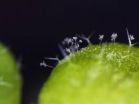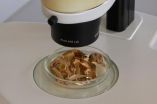(Press-News.org) Proteins are responsible for practically all vital functions in an organism. For example, they catalyze metabolic reactions, forward signals, transport particular substances and control immune system responses. Researchers established some years ago that proteins do not function independently of each other, but instead form complex networks.
"When you examine the protein networks, you find many similarities with online social networks," says Dr. Pascal Falter-Braun from TUM's Chair of Plant Systems Biology. "Some proteins are good networkers that maintain contact with many other protein molecules, while others are less interactive."
Different pathogens attack the same targets
By studying the plant model Arabidopsis thaliana (thale cress), the researchers found that pathogens specifically targeted the highly networked proteins. "We were surprised that pathogens as biologically dissimilar as bacteria and fungi manipulate the same proteins," Falter-Braun continues. These include proteins which control important processes in the cells, for example the transcription factors which activate genes for the production of new proteins.
It has been known for some time that these "hubs" are important for the entire network since they coordinate and synchronize distict processes. "The aim of pathogens is to weaken their host as much as possible, so they try to attack and take over the control centers of the cell, in other words the proteins with the most 'friends' in the network," explains Falter-Braun.
Control centers are largely unchanged
The central role of these proteins is also reflected in the fact that they have barely evolved over time. When organisms evolve, minor mutations can lead to changes in their molecules. If this results in an advantage for the particular organism, it is likely that the new properties will be passed on to its offspring.
In the case of highly networked proteins, such changes rarely occur, as Falter-Braun explains: "Since these proteins occupy such a central position in the network, it is very difficult for them to change without this having a negative impact on the plant."
It appears that the pathogens exploit this evolutionary conservation by targeting proteins that do not change - and therefore cannot elude the intruders.
Assistance from the network
At the same time, the networks appear to be structured in a way that helps them effectively defend the vulnerable hubs. The proteins that are particularly 'attractive' to the pathogens often have neighbors with mutations that are well tolerated by the network. Further study is required in order to understand how this "neighborhood watch" works and whether the network provides other defense mechanisms.
The fact that different pathogens attack the same proteins in the plant could open the door to cultivating crop plants that are more resistant. Whether the results can be transferred to other organisms – and even to humans – is a question that will require further research. "Since human proteins have undergone the same evolutionary processes, it is perfectly possible that the findings will apply to humans, too," concludes Falter-Braun.
INFORMATION:
Publication:
Convergent targeting of a common host protein-network by pathogen effectors from three kingdoms of life; Ralf Weßling, Petra Epple, Stefan Altmann, Yijian, Li Yang, Stefan R. Henz, Nathan McDonald, Kristin Wiley, Kai Christian Bader, Christine Gläßer, M. Shahid Mukhtar, Sabine Haigis, Lila Ghamsari, Amber E. Stephens, Joseph R. Ecker, Marc Vidal, Jonathan D. G. Jones, Klaus F. X. Mayer, Emiel Ver Loren van Themaat, Detlef Weigel, Paul Schulze-Lefert, Jeffery L. Dangl, Ralph Panstruga, and Pascal Braun; Cell Host & Microbe, DOI: 10.1016/j.chom.2014.08.004
Contact:
Dr. Pascal Falter-Braun
Technische Universität München
Chair of Plant Systems Biology
Tel.: +49 8161 71-5645
pbraun@wzw.tum.de
http://www.sysbiol.wzw.tum.de
Good networkers make prime targets
Pathogens specifically target multi-function proteins
2014-09-16
ELSE PRESS RELEASES FROM THIS DATE:
Cancer-fighting cocktail demonstrates promising results as treatment for advanced cervical cancer
2014-09-16
DALLAS – September 15, 2014 – Combining a standard chemotherapy drug with a second drug that stops cells from dividing improves both the survival and response rates for those with advanced cervical cancer, a new study by UT Southwestern Medical Center cancer researchers finds.
The cancer-fighting cocktail, which combines the chemotherapy drug cisplatin with pemetrexed - an agent that stops cancer cells from dividing - showed promising results for advanced, persistent, or recurrent cervical cancer.
"We found that pemetrexed combined with cisplatin is less toxic, well ...
Caving to cravings? Indulging in junk food linked to lapses in brain function
2014-09-16
Overindulging in high-calorie snacks is partly caused by lapses in a very specific part of the brain, according to a new University of Waterloo study.
The study, published in Psychosomatic Medicine: Journal of Biobehavioral Medicine, is the first to conclusively link reduced operation of the dorsolateral prefrontal cortex with self-restraint in the dietary context.
"It has long been thought that the dorsolateral prefrontal cortex helps to keep automatic, or knee-jerk, reactions in check," said Professor Peter Hall, senior author on the study. "We discovered that when ...
Powerful synergies across different sectors improve health of poor women and children
2014-09-16
New studies have uncovered the specific interventions and advances that have led to the success with these at-risk populations in the poorest countries.
New research across 142 countries finds that some 50 percent of the reduction in under-five child mortality in those countries is attributable to high impact health interventions such as early immunizations and skilled birth attendance.
The remaining 50 percent is due to factors outside the health sector, such as girls' education, women's participation in politics and the workforce, reduction of fertility rates, access ...
A new therapeutic target may prevent blindness in premature babies at risk of retinopathy
2014-09-16
This news release is available in French. According to a study conducted by pediatricians and researchers at Sainte-Justine University Hospital Research Center (Sainte-Justine) and Université de Montréal published online in the prestigious medical journal Nature Medicine on September 14, 2014, the activation of a receptor that migrates to the nucleus of nerve cells in the retina promotes the growth of blood vessels. The finding opens the possibility of developing new, more selective drugs to control the abnormal growth of blood vessels and prevent blindness including ...
What's for dinner? Rapidly identifying undescribed species in a commercial fungi packet
2014-09-16
For lovers of wild foods, autumn harks a season of bounty. Fungi of dizzying variety erupt from wood and soil, luring intrepid collectors to woodlands in search of elusive but delectable wild mushrooms. Part of their appeal lies in the allure of the treasure hunt, and their mysterious not-quite-meat, not-quite-vegetable qualities that belie an almost otherworldly existence. But are the mushrooms which you are eating known to science?
The Fungi Kingdom is enormously diverse yet vastly underdocumented – although some estimates range up to 10 million species, only about ...
Imaging identifies asymptomatic people at risk for stroke
2014-09-16
OAK BROOK, Ill. – Imaging can be a cost-effective way to identify people at risk for stroke who might benefit from aggressive intervention, according to a new modeling study published online in the journal Radiology.
The study looked at people with asymptomatic carotid artery stenosis, a narrowing of the major blood vessels supplying blood to the head due to atherosclerosis, or plaque buildup. Carotid artery stenosis is the primary cause of up to 20 percent of ischemic strokes, which result from an obstruction within a blood vessel and make up 85 percent of all strokes. ...
Researchers debunk myth about Parkinson's disease
2014-09-16
Using advanced computer models, neuroscience researchers at the University of Copenhagen have gained new knowledge about the complex processes that cause Parkinson's disease. The findings have recently been published in the prestigious Journal of Neuroscience.
The defining symptoms of Parkinson's disease are slow movements, muscular stiffness and shaking. There is currently no cure for the condition, so it is essential to conduct innovative research with the potential to shed some light on this terrible disruption to the central nervous system. Using advanced computer ...
Dental and nutrition experts call for radical rethink on free sugars intake
2014-09-16
Sugars in the diet should make up no more than 3% of total energy intake to reduce the significant financial and social burdens of tooth decay, finds new research from UCL (University College London) and the London School of Hygiene & Tropical Medicine.
The study, published in the open-access journal BMC Public Health, analysed the effect of sugars on dental caries, also known as tooth decay. They show that sugars are the only cause of tooth decay in children and adults.
Free sugars are defined by the World Health Organisation Nutrition Guidance Adivisory Group as follows: ...
Collaboration drives achievement in protein structure research
2014-09-15
When this week's print issue of the journal Science comes out, a collective cheer will go up from New Mexico, Montana and even the Netherlands, thanks to the type of collaborative effort that is more and more the norm in these connected times. Yes, the research was brilliant, and if we're lucky, it will produce innovations in biology, medicine, biotechnology and agriculture. It could save lives, and it happened because this scientist talked with that one, that one knew another one, and brilliant minds overcame geographic distance to advance human understanding.
"It is ...
Certain form of baldness at age 45 linked to higher risk of aggressive prostate cancer
2014-09-15
A new, large cohort analysis from the prospective Prostate, Lung, Colorectal and Ovarian (PLCO) Cancer Screening Trial, indicates that men who had moderate baldness affecting both the front and the crown of their head at age 45 were at a 40% increased risk of developing aggressive prostate cancer (usually indicates a faster growing tumor resulting in poorer prognosis relative to non-aggressive prostate cancer) later in life, compared to men with no baldness. There was no significant link between other patterns of baldness and prostate cancer risk. The study, published September ...
LAST 30 PRESS RELEASES:
New expert guidance urges caution before surgery for patients with treatment-resistant constipation
Solar hydrogen can now be produced efficiently without the scarce metal platinum
Sleeping in on weekends may help boost teens’ mental health
Study: Teens use cellphones for an hour a day at school
After more than two years of war, Palestinian children are hungry, denied education and “like the living dead”
The untold story of life with Prader-Willi syndrome - according to the siblings who live it
How the parasite that ‘gave up sex’ found more hosts – and why its victory won’t last
When is it time to jump? The boiling frog problem of AI use in physics education
Twitter data reveals partisan divide in understanding why pollen season's getting worse
AI is quick but risky for updating old software
Revolutionizing biosecurity: new multi-omics framework to transform invasive species management
From ancient herb to modern medicine: new review unveils the multi-targeted healing potential of Borago officinalis
Building a global scientific community: Biological Diversity Journal announces dual recruitment of Editorial Board and Youth Editorial Board members
Microbes that break down antibiotics help protect ecosystems under drug pollution
Smart biochar that remembers pollutants offers a new way to clean water and recycle biomass
Rice genes matter more than domestication in shaping plant microbiomes
Ticking time bomb: Some farmers report as many as 70 tick encounters over a 6-month period
Turning garden and crop waste into plastics
Scientists discover ‘platypus galaxies’ in the early universe
Seeing thyroid cancer in a new light: when AI meets label-free imaging in the operating room
Neutrophil-to-lymphocyte ratio may aid risk stratification in depressive disorder
2026 Seismological Society of America Annual Meeting
AI-powered ECG analysis offers promising path for early detection of chronic obstructive pulmonary disease, says Mount Sinai researchers
GIMM uncovers flaws in lab-grown heart cells and paves the way for improved treatments
Cracking the evolutionary code of sleep
Medications could help the aging brain cope with surgery, memory impairment
Back pain linked to worse sleep years later in men over 65, according to study
CDC urges ‘shared decision-making’ on some childhood vaccines; many unclear about what that means
New research finds that an ‘equal treatment’ approach to economic opportunity advertising can backfire
Researchers create shape-shifting, self-navigating microparticles
[Press-News.org] Good networkers make prime targetsPathogens specifically target multi-function proteins




